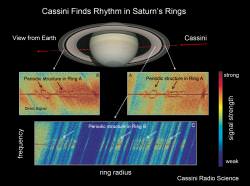Cassini has been orbiting around Saturn for almost four years, and amazingly, the spacecraft keeps discovering new and unexpected features about this world and its system of rings and moons. Recently, in two of Saturn’s rings, Cassini found orderly lines of densely grouped, boulder-size icy particles that extend outward across the rings like ripples from a rock dropped in a calm pond. Surprisingly, the distances between these ring particles stay relatively equal even though their velocities may change. This type of pattern is completely new, as normally, the distances between particles change with their velocity.
The pattern was detected when Cassini sent out three signals toward Earth. The signals crossed Saturn’s rings, and the frequencies were scattered from the passing ring particles. Once the signals were captured by Earth-based antennas of NASA’s Deep Space Network, Cassini scientists saw a regular pattern in the received signal frequencies.
“This particular feature is the smallest and most detailed of anything seen in Saturn’s rings so far,” said Cassini radio science team member Essam Marouf. “In the chaotic environment of the rings, to find such regularity in the most cramped areas is nothing short of amazing.” The regular structure can only be found in locations where particles are densely packed together, such as the B ring and the innermost part of the A ring. The signals were sent to capture a complete view of the rings.
The unexpected pattern within Saturn’s rings may give scientists some new ideas of what to expect from other similar planets and solar systems.
Scientists call this pattern of particles “enormously extended natural diffraction grating.” A diffraction grating has parallel lines like a picket fence; when light hits this fence, it separates according to wavelength, from ultraviolet to infrared light.
“The signals showed that the particle groups were arranged in an unexpectedly regular formation that had rhythm within the rings of Saturn,'” said Marouf. “Each particle is in its own orbit, and sometimes they collide and move apart as their velocities change. As a result, you have particles bunched together into dense groups that extend across the ring in harmony with each other.”
Original News Source: Cassini Press Release


This is just a thought experiment. The rings of Saturn are like the rings of electrons around a nucleus. Therefore, there must be electromagnetic charge parity between the rings and Saturn as there is between the orbiting electrons around the orbiting quark nucleus. The rings must be in resonance with Saturn otherwise chaos (entropy) would result and the rings would not survive. The resonance factor should be the same ratio as the alpha constant. My predicted value for this alpha resonance is 729 and not 729.7352568.
Maybe its a secret message, something like: “Hello you dummies, when are you going to send another spacecraft?” or, “Carolyn Porco is mucho HOT!”
triuneconcept – what’choo talkin’ ’bout? The orbitals of electrons about a nucleus is nothing like the rings of Saturn. They appear as spheres or dumbells – there’s nothing planer about ’em.
Bar Code?
I take great interest in the suggestion of the word harmony as used to imaine this phenominon; it truly speak of the nature of the harmony of the spheres!